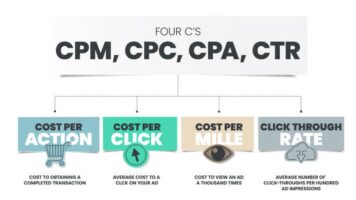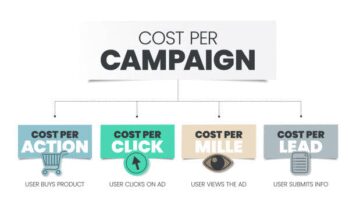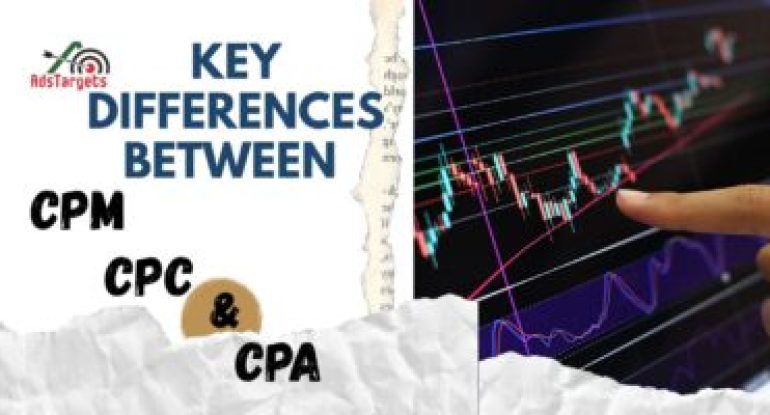If you’re a publisher or advertiser trying to run online ads, all those digital marketing terms can feel like learning a new language. CPM, CPC, CPA, CPI, CPL, CVC—it can sound like alphabet soup at first. But don’t worry, once you get the hang of it, these terms become your secret weapon for running smarter campaigns and making more money.
The key is knowing the difference between CPM, CPC and CPA, since those are the big three models most advertisers use. Once you understand how they work (and how they affect your budget), you’ll be able to choose the right one for your campaign. From there, you can use other advertising metrics to figure out if your ads are really pulling their weight.
In this guide, we’ll break down the basics of CPM, CPC, CPA, plus a few others like CPL, CPI, and CVC, in simple terms even a ten-year-old can follow. By the end, you’ll know the difference between CPM, CPC and CPA—and exactly how to pick the model that gives you the best bang for your ad spend.
Table of Contents
ToggleCPC VS CPM: WHAT’S THE REAL DIFFERENCE?

CPC and CPM are two of the most common ways advertisers pay for ads, but they work very differently. Understanding them (and the difference between CPM, CPC and CPA) will help you pick the right model for your goals.
#1. CPC (Cost Per Click):
This one is simple—you only pay when someone actually clicks your ad. Think of it like paying for results. If nobody clicks, you don’t spend a cent. This model is great for driving traffic to your website, generating leads, or getting people to take action. It’s often more expensive than CPM, but you know you’re paying for real engagement. Big players like Google Ads and Facebook love using CPC because it keeps things performance-driven.
#2. CPM (Cost Per Mille):
“Mille” just means one thousand. So CPM is the price you pay for every 1,000 people who see your ad. It doesn’t matter if they click or not—it’s all about visibility. CPM sits at the top of the marketing funnel, which means it’s perfect for building brand awareness. If you want people to notice your brand, logo, or message everywhere, CPM is your friend.
Now here’s the kicker: CPC often drives more clicks and traffic, while CPM is better for broad exposure. Knowing the difference between CPM, CPC and CPA helps advertisers decide whether they want visibility, clicks, or actual sales.
#3. CPA (Cost Per Action):
While CPC and CPM focus on views and clicks, CPA takes it one step further—you only pay when someone completes a specific action, like signing up, downloading an app, or buying a product. This is the most results-focused model and usually costs more, but it delivers the highest-quality outcomes.
CPA VS CPC: WHAT’S THE DIFFERENCE?

CPA (Cost Per Action/Acquisition):
With CPA, advertisers only pay when someone does a specific action—like making a purchase, signing up for a newsletter, or downloading an app. It’s a favorite for brands because they’re only spending money when they get real results. Think of it as “no action, no payment.”
But here’s the catch: publishers (the people showing the ads) carry the risk. If their audience sees the ad but doesn’t buy, sign up, or download, they don’t earn anything. That’s why some publishers aren’t big fans of CPA—it can be hit or miss.
CPC (Cost Per Click):
Now, CPC is a bit easier for publishers. Every time someone clicks an ad, they get paid—whether or not the person buys something later. For advertisers, this is about paying for engagement. For publishers, it’s less risky than CPA because they don’t have to wait for a full sale or sign-up to happen.
So, here’s the difference between CPM, CPC and CPA in simple terms:
CPM = Pay for views (good for awareness).
CPC = Pay for clicks (good for traffic).
CPA = Pay for actions (good for conversions).
Advertisers love CPA because it’s super cost-efficient, but publishers often prefer CPC because it gives them quicker rewards. Knowing the difference between CPM, CPC and CPA helps both sides pick the best model for their goals.
CPC VS CTR: WHAT’S THE DIFFERENCE?
CPC (Cost Per Click):
This is all about money. CPC tells you how much an advertiser pays every single time someone clicks on their ad. Think of it like paying a small fee whenever a curious person taps the ad to learn more.
CTR (Click-Through Rate):
This isn’t about money—it’s about performance. CTR measures how many people actually clicked the ad after seeing it. For example, if 100 people see an ad and 5 click on it, the CTR is 5%. A high CTR means the ad is interesting and really connects with the audience.
So, the difference between CPC and CTR is simple:
CPC = how much each click costs.
CTR = how many people are clicking in the first place.
You need both to know if your ad campaign is winning or wasting money. Advertisers look at CPC to manage costs and at CTR to judge if people even care about the ad. Knowing the difference between CPC and CTR helps marketers balance cost with performance for better results.
CPC VS CPV: WHAT’S THE DIFFERENCE?
CPC (Cost Per Click):
This is when advertisers pay each time someone actually clicks on their ad. It doesn’t matter if it’s a search ad, a banner on a website, or even a video ad—if a person taps on it, the advertiser gets billed.
Now this one is all about video ads. With CPV, advertisers pay when someone watches their video. Sometimes it’s counted when a viewer watches a few seconds, or when they stick around for most of the ad. Either way, CPV is the go-to choice for brands that want people to see and remember their video content—especially app marketers and businesses chasing brand awareness.
So, the difference between CPC and CPV is simple:
CPC = money for clicks.
CPV = money for views.
Both are useful in different ways. If your goal is to get people to visit your website or app, CPC works best. But if you just want your video seen by as many eyes as possible, CPV is the winner. Understanding the difference between CPC and CPV helps advertisers choose the smarter way to spend their budget.
CPM VS CPV: WHAT’S THE DIFFERENCE?

CPM (Cost Per Mille):
This is how much advertisers pay for every 1,000 times their ad is shown. It doesn’t matter if people click or watch—it’s all about impressions. CPM is often the go-to when you want as many people as possible to see your brand and remember it. That’s why it’s super popular for brand awareness campaigns.
CPV (Cost Per View):
This one is all about video ads. With CPV, advertisers only pay when someone actually views their video. Sometimes that means a few seconds, sometimes longer—but either way, it’s about people watching. CPV is especially common for mobile app campaigns or businesses trying to grab attention through video.
So, the difference between CPM and CPV is clear:
CPM charges for impressions (views of an ad, whether or not people pay attention).
CPV charges for video views (when someone actually watches).
Understanding the difference between CPM and CPV helps advertisers pick the right strategy. Want cheap, wide exposure? Go with CPM. Want real eyeballs on your video? CPV is your best bet.
CPV VS CPA: WHAT’S THE DIFFERENCE?
CPA (Cost Per Action):
This pricing model means advertisers only pay when a user does a specific thing—like buying a product, signing up for a newsletter, or downloading an app. It’s super results-focused because payment only happens after an actual action.
CPV (Cost Per View):
This one is all about videos. Advertisers pay when someone watches their video ad for a set amount of time. It could be a YouTube ad, a mobile app promo, or a pop-up video. If the viewer doesn’t watch, the advertiser doesn’t pay.
So, what’s the difference between CPV and CPA?
CPA is broader—it covers any action (click, purchase, signup, download).
CPV is narrower—it’s only about watching videos.
CPA VS CPM: WHAT’S THE DIFFERENCE?
CPA (Cost Per Action):
With CPA ads, advertisers only pay when a user does something specific—like buying a product, signing up for a service, or downloading an app. The whole campaign is judged by how many people actually take action. For publishers, this can feel risky because if users don’t act, they don’t get paid.
CPM (Cost Per Mille/1,000 Impressions):
CPM ads are different. Advertisers pay for every 1,000 times an ad is shown, no matter if someone clicks, buys, or ignores it. For publishers, it’s less risky because they get paid just for showing the ad, not waiting for results.
So, the difference between CPA and CPM comes down to results vs. reach.
CPA = pay for actions (more risky for publishers, more rewarding for advertisers).
CPM = pay for impressions (safer for publishers, good for brand awareness).
CPM VS CPI: WHAT’S THE DIFFERENCE?
CPM (Cost Per Mille):
This means how much an advertiser pays every time their ad is shown 1,000 times. It doesn’t matter if people click, install, or ignore it—advertisers are paying just for visibility. CPM is super common for banner ads, native ads, and those little hover ads you see online.
CPI (Cost Per Install):
Now, this one is all about action. With CPI ads, advertisers only pay when someone actually installs an app, game, or piece of software. That’s why mobile app creators love CPI—it helps them spend money only when they gain new users.
So, the difference between CPM and CPI comes down to exposure vs. installs.
CPM = you’re paying for people seeing your ad.
CPI = you’re paying for people downloading your app.
CPC (Cost Per Click):
With CPC ads, advertisers pay every single time someone clicks on their ad. It doesn’t matter if the person buys something or not—the advertiser is charged for the click. That’s why CPC ads depend a lot on CTR (click-through rate), which shows how many people who saw the ad actually clicked on it.
CPI (Cost Per Install):
CPI works differently. Here, advertisers only pay when someone installs an app, game, or software after seeing the ad. So if 100 people see the ad but only 10 install the app, the advertiser only pays for those 10 installs.
S0, the difference between CPC and CPI is pretty clear:
CPC = you’re paying for clicks.
CPI = you’re paying for installs.
CPA VS CPI: WHAT’S THE DIFFERENCE?

CPI (Cost Per Install):
CPI is all about apps. Advertisers pay every time someone installs their app after seeing an ad. Years ago, when most apps cost just 99 cents, CPI was the go-to way to measure how well mobile ad campaigns were working.
CPA (Cost Per Action):
Today, things have changed. Apps are mostly free-to-play or freemium, which means the real money comes later—when people make purchases, subscribe, or take another action inside the app. That’s where CPA shines. With CPA, advertisers pay only when a user completes a valuable action, not just for installing the app.
The difference between CPA and CPI is this:
CPI = pay when users install your app.
CPA = pay when users take an action that brings real value, like a purchase or signup.
Knowing the difference between CPA and CPI helps advertisers decide if they just want downloads, or if they’re aiming for deeper engagement that makes the campaign more profitable.
CPL VS CPA: WHAT’S THE DIFFERENCE?
CPL (Cost Per Lead):
CPL means advertisers pay every time they get a lead from an ad. A lead could be someone filling out a form, dropping their email, or signing up for a free trial. Basically, you’re paying for contact info that you can follow up on later.
CPA (Cost Per Action):
CPA is broader. Instead of just leads, advertisers pay when a user completes any valuable action—like making a purchase, downloading an app, or subscribing to a service.
The difference between CPL and CPA comes down to what counts as success:
CPL = you pay for leads (names, emails, phone numbers).
CPA = you pay for actions (purchases, downloads, or signups).
Knowing the difference between CPL and CPA helps businesses choose whether they want to focus on simply gathering potential customer info, or paying only when users take a deeper step that drives sales.
CPM VS CPL: WHAT’S THE DIFFERENCE?

CPM (Cost Per Mille):
CPM means you pay for every 1,000 times your ad is shown, no matter if people click on it or not. It’s usually used to build brand awareness—kind of like getting your product in front of as many eyes as possible at the top of the marketing funnel.
CPL (Cost Per Lead):
CPL is a bit more focused. Instead of just showing your ad, you pay only when someone actually gives you their details—like their email address or phone number. This makes it super useful for businesses that want to collect leads for subscriptions, big purchases, or long-term customers.
The difference between CPM and CPL is easy to spot:
CPM = pay for ad views (awareness).
CPL = pay for actual leads (people who show interest).
Knowing the difference between CPM and CPL helps you decide if you just want attention for your brand, or real contacts you can follow up with to make sales later.
CPC VS CPL: WHAT’S THE DIFFERENCE?
CPC (Cost Per Click):
With CPC, advertisers pay only when someone actually clicks on their ad. It doesn’t matter if the person fills out a form or buys something—just the click itself counts.
CPL (Cost Per Lead):
CPL goes a step further. Instead of paying for clicks, advertisers pay when someone shows real interest by giving their contact info, like an email or phone number, through a form.
So, the difference between CPC and CPL is this:
CPC = pay for clicks.
CPL = pay for leads.
Understanding the difference between CPC and CPL is super important. If your goal is just to get more people to visit your site, CPC works great. But if you want actual contacts you can follow up with, CPL is the smarter choice.
Conclusion
Still scratching your head about which pricing model to use-CPM, CPC, CPL, CPA, CPI, or CPV? Don’t worry, you’re not alone. Each one sounds a little tricky at first, but the main thing is to know the difference between CPM, CPC and CPA, since those are the most common.
Here’s the short version:
CPM is about paying every time your ad is shown 1,000 times.
CPC means you pay only when someone actually clicks on your ad.
CPA is all about paying when a specific action happens—like a sale or signup.
Once you understand the difference between CPM, CPC and CPA, the other models (like CPL, CPI, and CPV) start to make a lot more sense because they are just variations.
At Adstargets, we make it easy. Instead of stressing over numbers and formulas, we help you pick the model that fits your business goals-whether that’s more eyeballs on your ads, more clicks, or more real customers.








